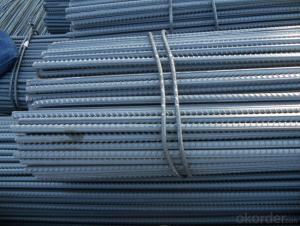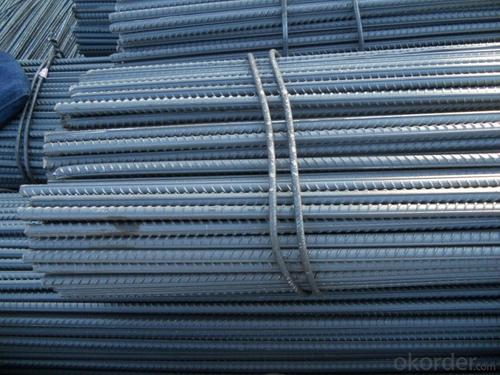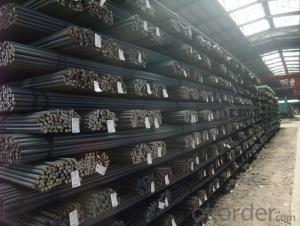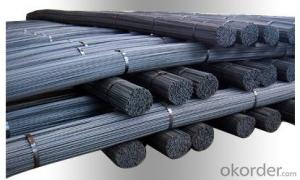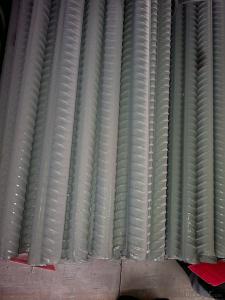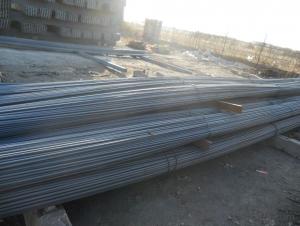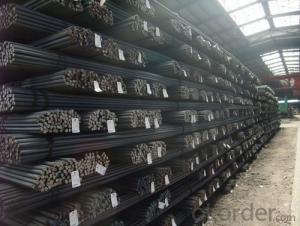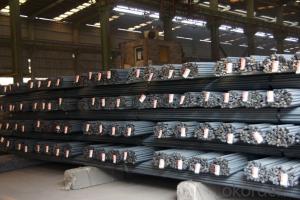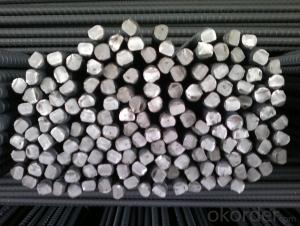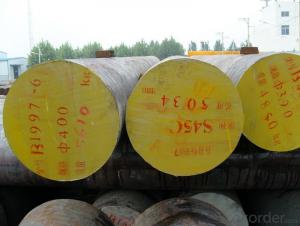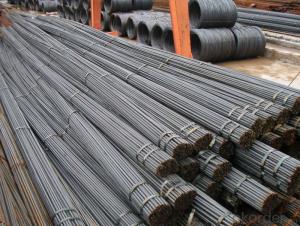Deformed Bars With Material Grade HRB400/500
- Loading Port:
- Tianjin
- Payment Terms:
- TT OR LC
- Min Order Qty:
- 25 m.t
- Supply Capability:
- 20000 m.t/month
OKorder Service Pledge
OKorder Financial Service
You Might Also Like
Specification
OKorder is offering Deformed Steel Bar with high quality at great prices with worldwide shipping. Our supplier is a world-class manufacturer of steel, with our products utilized the world over. OKorder annually supplies products to European, North American and Asian markets. We provide quotations within 24 hours of receiving an inquiry and guarantee competitive prices.
Note:
1. Our products are produced according to national standard (GB), if not, supply according to national standards (GB) or agreement as customer required.
2. Other Grade and Standard Deformed Steel Bar we can supply:
Grade: GR40/GR60, G460B/B500A/B500B/B500C,BST500S
Standard: ASTM, BS, DIN
3. We can not only supply Deformed Steel Bar; if you need anything about building materials, please contact us for further information.
4. Please send us your detail specifications when inquire. We will reply to you as soon as possible. We sincerely hope we can establish a long stable business relationship.
Product Applications:
Deformed Steel Bar with high quality are ideal for structural applications and are widely used in the construction of buildings and bridges, and the manufacturing, petrochemical, and transportation industries.
Product Advantages:
OKorder's Deformed Steel Bar with high quality are durable, strong, and resist corrosion.
Main Product Features:
· Premium quality
· Prompt delivery & seaworthy packing (30 days after receiving deposit)
· Corrosion resistance
· Can be recycled and reused
· Mill test certification
Product Specifications:
Standard | GB | HRB400 | |
Diameter | 10mm-32mm | ||
Length | 6M, 12M | ||
Place of origin | Hebei, China mainland | ||
Advantages | exact size, regular package, chemical and mechanical properties are stable. | ||
Type | Hot rolled deformed steel bar | ||
Chemical Composition:
Grade | Technical data of the original chemical composition (%) | ||||||
C | Mn | Si | S | P | V | ||
HRB400 | ≤0.25 | ≤1.60 | ≤0.80 | ≤0.045 | ≤0.045 | 0.04-0.12 | |
Physical capability | |||||||
Yield Strength (N/cm²) | Tensile Strength (N/cm²) | Elongation (%) | |||||
≥400 | ≥570 | ≥14 | |||||
FAQ:
Q1: Why buy Materials & Equipment from OKorder.com?
A1: All products offered by OKorder.com are carefully selected from China's most reliable manufacturing enterprises. Through its ISO certifications, OKorder.com adheres to the highest standards and a commitment to supply chain safety and customer satisfaction.
Q2: How do you guarantee the quality of our products?
A2: We have established an advanced quality management system which conducts strict quality tests at every step, from raw materials to the final product. At the same time, we provide extensive follow-up service assurances as required.
Q3: What is the normal tolerance of your steel products ?
A3: Normally 1%-3%, but we can also produce the goods according to the customers' requests
Q4:What's your payment terms ?
A4:Mostly,we collect the money by T/T and LC at sight . We also accept time LC at 90/120 days sight.
Image:
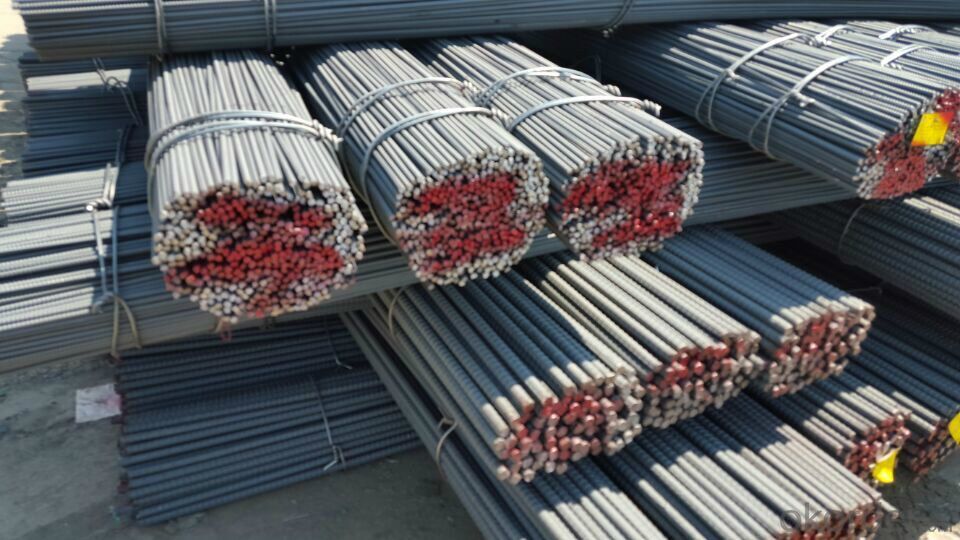

- Q: What are the guidelines for the proper spacing of steel rebars in columns?
- Various national and international codes and standards, such as the American Concrete Institute (ACI) and the British Standards Institution (BSI), provide guidelines for the proper spacing of steel rebars in columns. These guidelines are crucial in ensuring the durability and structural integrity of reinforced concrete columns. The spacing of steel rebars in columns is primarily influenced by the following factors: 1. Concrete cover: Codes specify a minimum concrete cover to protect the steel reinforcement from corrosion and provide fire resistance. The spacing between rebars should maintain a uniform concrete cover around each rebar. 2. Rebar diameter: The size or diameter of rebars affects their spacing. Codes mandate a minimum clear spacing between adjacent rebars based on their diameter to prevent congestion and ensure proper concrete placement. 3. Column dimension: The size and shape of the column play a significant role in determining rebar spacing. Larger columns may require more rebars compared to smaller ones to provide sufficient reinforcement and resist applied loads. 4. Load and design requirements: Design loads, including dead loads, live loads, and seismic loads, impact rebar spacing. Codes provide guidelines on the minimum amount of reinforcement required based on column dimensions and anticipated loads. 5. Structural detailing: Proper detailing is crucial to ensure rebars are adequately anchored and lapped, developing the required bond strength. Codes provide guidelines for lapping lengths, anchorage lengths, and splices to ensure force transfer between rebars and concrete. Consulting the specific code or standard applicable in your region is crucial to determine the exact guidelines for rebar spacing in columns. It is also recommended to involve a qualified structural engineer or designer to perform detailed analysis and design of reinforced concrete columns, ensuring compliance with the appropriate guidelines and achieving a safe and efficient structural system.
- Q: What are the advantages of using fiber-reinforced polymer (FRP) rebars over steel rebars?
- There are several advantages of using fiber-reinforced polymer (FRP) rebars over steel rebars. Firstly, FRP rebars are significantly lighter than steel rebars, making them easier to handle and transport. Additionally, FRP rebars have a higher tensile strength than steel rebars, allowing for greater flexibility in design and reducing the need for additional reinforcement. FRP rebars are also non-corrosive, unlike steel rebars which can rust over time, making them more durable and longer-lasting. Lastly, FRP rebars are non-conductive, making them suitable for use in areas with electrical or magnetic fields. Overall, the use of FRP rebars offers numerous advantages in terms of weight, strength, durability, and versatility.
- Q: Can steel rebars be used in structures with limited construction regulations?
- Yes, steel rebars can be used in structures with limited construction regulations. Steel rebars are commonly used in construction due to their high tensile strength and durability. However, it is important to note that even in structures with limited regulations, it is crucial to follow basic safety guidelines and ensure proper engineering and construction practices to ensure the structural integrity and safety of the building.
- Q: Can steel rebars be used in structures with limited construction materials?
- Yes, steel rebars can be used in structures with limited construction materials. Steel rebars are commonly used as reinforcement in concrete structures to provide strength and stability. They can be easily transported and installed, making them suitable for construction projects in areas with limited access to construction materials. Additionally, steel rebars have high tensile strength, which enhances the durability and load-bearing capacity of structures, making them a reliable choice in resource-constrained environments.
- Q: Are steel rebars suitable for use in hospital construction?
- Yes, steel rebars are suitable for use in hospital construction. Steel rebars provide excellent strength and durability, making them ideal for reinforcing concrete structures in hospitals. They ensure the integrity of the building, withstand heavy loads, and enhance the overall safety and stability of the hospital.
- Q: Why is thread steel thinner than crude?
- Reduce the quality of the project, and the use of low carbon steel instead of rebar. For large engineering projects, often appear to "project inspector", to replace the steel rib steel "Choulianghuanzhu", reduce the construction cost. In the design, because the members allowed to provide "stirrup stress support", the main role is to keep the shape and location of longitudinal reinforcement, steel strapping has a smooth surface, accurate positioning, therefore, in addition to longitudinal reinforcement, licensing round steel stirrups. The longitudinal reinforcement must be made of rib steel.
- Q: What is the process of anchoring steel rebars in concrete?
- The process of anchoring steel rebars in concrete involves several steps to ensure a strong and secure bond between the rebar and the concrete. First, the concrete surface where the rebar will be anchored needs to be prepared. This typically involves cleaning the surface to remove any dirt, dust, or debris that could interfere with the bonding process. It is also important to ensure that the concrete is fully cured and has reached the required strength before proceeding. Next, the rebar is cut to the desired length and shape according to the construction plans. It is important to follow the specified dimensions and placement requirements to ensure proper reinforcement and structural integrity. After the rebar is prepared, it is usually placed in the desired position within the concrete formwork. The rebar should be positioned at the correct depth and spacing as specified by the design. This is typically accomplished by using plastic or metal chairs, spacers, or tie wire to hold the rebar in place. Once the rebar is properly positioned, the next step is to secure it to the concrete. One common method of anchoring the rebar is by using mechanical anchors or rebar couplers. These devices are designed to create a strong connection between the rebar and the concrete by utilizing various mechanisms such as threading, crimping, or expansion. Alternatively, another method of anchoring the rebar is by using adhesive or cementitious grouts. These materials are applied to the rebar and then inserted into pre-drilled holes in the concrete. The adhesive or grout helps to bond the rebar to the concrete and provides additional reinforcement. Finally, after the rebar is anchored, the concrete is poured or placed around it. The concrete should be properly consolidated to ensure that it fully surrounds and encases the rebar. This can be achieved through techniques such as vibrating the concrete or using specialized equipment. Overall, the process of anchoring steel rebars in concrete involves careful planning, preparation, and execution to ensure a reliable and durable bond between the rebar and the concrete. Following industry standards and design specifications is crucial to achieve the desired structural strength and integrity.
- Q: What is the lifespan of steel rebars?
- The longevity of steel rebars can differ based on various elements including the steel's quality, environmental circumstances, and maintenance methods. In general, steel rebars possess an extensive lifespan and are specifically engineered to provide structural reinforcement for numerous years. When properly installed and maintained, steel rebars can endure for several decades or even surpass a century. Nevertheless, factors such as exposure to corrosive surroundings or inadequate maintenance can considerably diminish their lifespan. Routine examinations, protective coatings, and appropriate drainage systems can aid in prolonging the lifespan of steel rebars and guaranteeing their long-lasting durability.
- Q: What are the different methods of joining steel rebars in a structure?
- There are several methods for joining steel rebars in a structure, such as lap splicing, mechanical splicing, and welded splicing. Lap splicing involves overlapping the rebars and tying them together with wire or steel ties. Mechanical splicing uses mechanical devices like couplers or sleeves to connect the rebars together. Welded splicing involves welding the rebars together using heat and pressure to create a strong bond. Each method has its advantages and is used based on the specific requirements of the structure and the engineer's recommendations.
- Q: Can steel rebars be used in bridge construction?
- Yes, steel rebars are commonly used in bridge construction. They provide strength and reinforcement to the concrete used in bridge components such as beams, columns, and foundations. Steel rebars enhance the structural integrity and load-bearing capacity of the bridge, making it a durable and long-lasting infrastructure.
Send your message to us
Deformed Bars With Material Grade HRB400/500
- Loading Port:
- Tianjin
- Payment Terms:
- TT OR LC
- Min Order Qty:
- 25 m.t
- Supply Capability:
- 20000 m.t/month
OKorder Service Pledge
OKorder Financial Service
Similar products
Hot products
Hot Searches
Related keywords
